文献翻译—汽车转向系统的发展
- 格式:doc
- 大小:88.00 KB
- 文档页数:10

汽车电动助力转向系统的发展汽车电动助力转向系统是一种利用电动机辅助车辆转向的技术。
随着科技的进步和人们对驾驶体验的要求不断提高,汽车电动助力转向系统在近年来得到了快速发展。
汽车电动助力转向系统的发展可以追溯到20世纪60年代,当时一些高档车型开始使用液压助力转向系统,通过液压泵和转向助力器来提供转向的辅助力。
这种系统存在液压泄漏、能效低下等问题,而且在高速行驶时往往会感受到转向过重的现象。
为了解决这些问题,汽车电动助力转向系统逐渐取代了液压助力转向系统。
这种系统利用电动机代替了液压泵,通过转向助力器将电动机提供的力量传递给转向装置,实现转向的辅助作用。
相比于液压助力转向系统,电动助力转向系统具有体积小、重量轻、响应速度快、能耗低等优点,大大提高了转向的精度和舒适性。
随着电动助力转向系统的发展,一种新型的系统被引入,即电动助力转向系统。
这种系统将电动助力转向系统与机械助力转向系统相结合,通过电动机和传统的转向齿轮机构相互协调工作,实现最佳的转向效果。
电动机可以在低速行驶时提供更大的助力,而在高速行驶时逐渐减小助力,以保证转向的稳定性和安全性。
近年来,一些车辆制造商开始使用电子控制系统来进一步提升汽车电动助力转向系统的功能。
通过与车辆的其他系统相连接,电子控制系统可以实现自动驾驶、路径规划、防抱死制动等高级功能,大大提高了驾驶的便利性和安全性。
除了在传统的内燃机汽车上使用,电动助力转向系统在电动汽车和混合动力汽车上也得到了广泛应用。
由于电动汽车和混合动力汽车通常具有较高的动力输出,因此需要更强的转向辅助力来应对不同的驾驶条件。
汽车电动助力转向系统通过与电动机和电池系统相连接,可以提供更大的辅助力,满足车辆的转向需求。
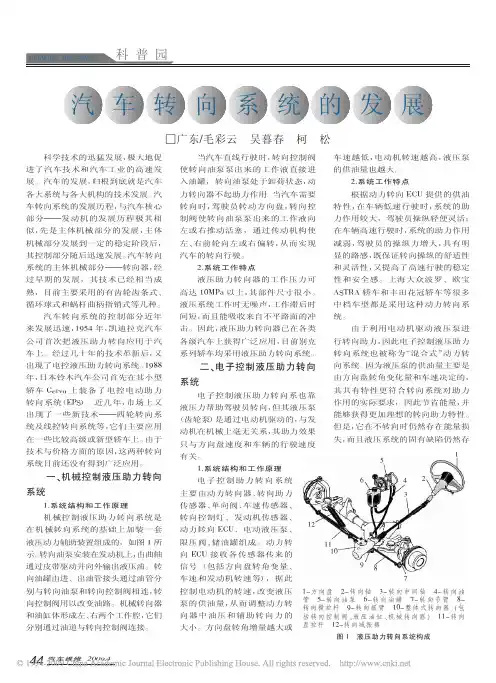
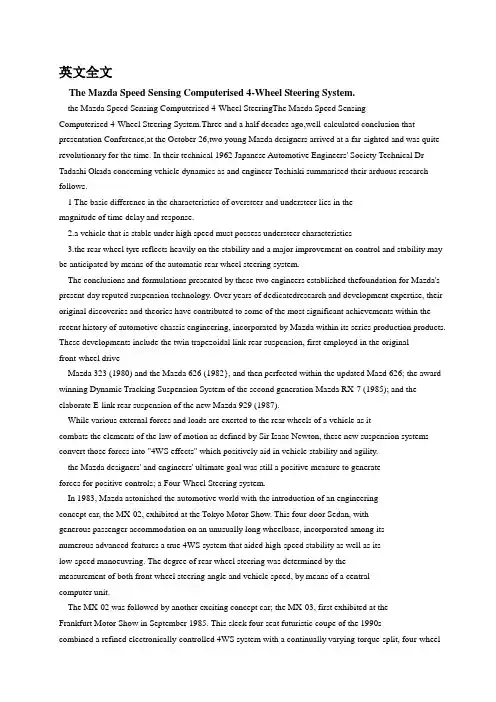
英文全文The Mazda Speed Sensing Computerised 4-Wheel Steering System.the Mazda Speed Sensing Computerised 4-Wheel SteeringThe Mazda Speed SensingComputerised 4-Wheel Steering System.Three and a half decades ago,well-calculated conclusion that presentation Conference,at the October 26,two young Mazda designers arrived at a far-sighted and was quite revolutionary for the time. In their technical 1962 Japanese Automotive Engineers' Society Technical Dr Tadashi Okada concerning vehicle dynamics as and engineer Toshiaki summarised their arduous research follows.1 The basic difference in the characteristics of oversteer and understeer lies in themagnitude of time delay and response.2.a vehicle that is stable under high speed must possess understeer characteristics3.the rear wheel tyre reflects heavily on the stability and a major improvement on control and stability may be anticipated by means of the automatic rear wheel steering system.The conclusions and formulations presented by these two engineers established thefoundation for Mazda's present-day reputed suspension technology. Over years of dedicatedresearch and development expertise, their original discoveries and theories have contributed to some of the most significant achievements within the recent history of automotive chassis engineering, incorporated by Mazda within its series production products. These developments include the twin trapezoidal link rear suspension, first employed in the originalfront-wheel driveMazda 323 (1980) and the Mazda 626 (1982}, and then perfected within the updated Mazd 626; the award winning Dynamic Tracking Suspension System of the second generation Mazda RX-7 (1985); and the elaborate E-link rear suspension of the new Mazda 929 (1987).While various external forces and loads are exerted to the rear wheels of a vehicle as itcombats the elements of the law of motion as defined by Sir Isaac Newton, these new suspension systems convert those forces into "4WS effects" which positively aid in vehicle stability and agility.the Mazda designers' and engineers' ultimate goal was still a positive measure to generateforces for positive controls; a Four-Wheel Steering system.In 1983, Mazda astonished the automotive world with the introduction of an engineeringconcept car, the MX-02, exhibited at the Tokyo Motor Show. This four-door Sedan, withgenerous passenger accommodation on an unusually long wheelbase, incorporated among itsnumerous advanced features a true 4WS system that aided high-speed stability as well as itslow-speed manoeuvring. The degree of rear wheel steering was determined by themeasurement of both front wheel steering angle and vehicle speed, by means of a centralcomputer unit.The MX-02 was followed by another exciting concept car; the MX-03, first exhibited at theFrankfurt Motor Show in September 1985. This sleek four seat futuristic coupe of the 1990scombined a refined electronically-controlled 4WS system with a continually varying torque-split, four-wheeldrive system and a powerful three-rotary engine.Mazda Electronically一Controlled Four-Wheel Steering System:A Beneficial TechnologyMazda's electronically-controlled, vehicle-speed-sensing Four-Wheel Steering System (4WS}steers the rear wheels in a direction and to a degree most suited to a corresponding vehicle speed range. The system is mechanically and hydraulically actuated, producing greatly enhanced stability, and within certain parameters, agility.The driver of a Mazda 4W5-equipped car derives five strategic benefits, over and above the conventional vehicle chassis.1.Superior cornering stability2.Improved steering responsiveness and precision3.High-speed straightline stability4.Notable improvement in rapid lane-changing manoeuvres5.Smaller turning radius and tight-space manoeuvrability at low vehicle speed rangeThe most outstanding advantage of the Mazda 4WS is that it contributes to a notable reduction in driver fatigue over high-speed and extended travelling. This is achieved by optimally:1 .reducing the response delay to steering input and action and2. eliminating the vehicle's excessive reaction to steering inputIn essence, by providing the optimum solution to the phenomena researched by the two youngMazda engineers in the early sixties一by the method advocated by them一the 4WS system has emerged as a fully beneficial technology. Strategic ConstructionThe Mazda 4WS consists of a rack-and-pinion front steering system that is hydraulically assisted by atwin-tandem pump main power source, with an overall steering ratio of 14.2:1.The rear wheel steering mechanism is also hydraulically assisted by the main pump andelectronically controlled一according to the front steering angle and vehicle speed. The rearsteering shaft extends from the rack bar of the front steering gear assembly to the rearsteering-phase control unit.The rear steering system is comprised of the input end of the rear steering shaft, vehicle speed sensors, a steering-phase control unit {determining direction and degree), a power cylinder andan output rod. A centering lock spring is incorporated, which locks the rear system in a neutral (straightforward} position in the event of hydraulic failure. Additionally, a solenoid valve that disengages hydraulic assist (thereby activating the centering lock spring} in case of anelectrical failure is ineluded.The 4WS system varies the phase and ratio of the rear-wheel steering to the front wheels,according to the vehicle speed. It steers the rear wheels toward the opposite phase (direction}of the front wheel during speeds less than 35kmlh (22mph} for a tighter turn and "neutralizes"them (to a straightforward direction, as in a conventional two-wheel steering principle} at35kmlh (22mph}. Above that speed, the system steers toward the same phase-direction as thefront wheels, thereby generating an increased cornering force for stability. The maximunsteering angle of the rear wheels extends 5 degrees to either left or right, a measurement th敏Mazda has determined to be optimally effective and natural to human sensitivity.Primary Components1. Vehicle speed sensors Interpret speedometer shelf revolutions and send signal to theelectronic computer unit. two sensors, one within the speedometer and the other atthe transmission output, are used to crosscheck the other for accuracy and failsafemeasures.2. Steering phase control unit Conveys to the power steering cylinder booster valve the direction and stroke of rear wheel steering by the combined movement of the control yoke angle and bevel gear revolutions.3.Electric stepper motor Performs altering of the yoke angle and bevel gear phasing4.Rear steering shaft Transmits front wheel steering angle by turning the small bevelgear in the steering phase control unit, which rotates the main bevel gear in the assembly.5.Control valve Feeds hydraulic pressure to the steering actuator, according to thephase and stroke required for appropriate rear wheel steering.6.Hydraulic power cylinder Operates the output rod by hydraulic pressure and steersthe rear wheels. It locks the rear wheels in a "neutral" (straightforward) position withthe centering lock spring, which is activated by a solenoid valve in case of failure toensure a normal 2WS function for the vehicle.7.Hydraulic pump. Provides hydraulic pressure to both the front and rear steering Systems.Details of Steering Phase Control UnitThe steering phase control unit alters the direction and degree of rear wheel steering. It consists of a stepper motor that controls the rear steering ratio, a control yoke, a swing arm, a main bevel gear engaged to the rear steering shaft via a small bevel gear, and a control rod connected to the control valve. It operates:a. Opposite phase (direction) steering under 35kmlh (22mph)1.Control Yoke is at an angle activated by the stepper motor2.Front wheels are steered to the right. The small bevel gear is rotated in direction X bythe rotation of the rear steering shaft. The small bevel gear, in turn, rotates the mainbevel gear.3.Rotation of the main bevel gear causes movement of the control rod toward the control valve.4.Input rod of the control valve is pushed to the right, according to the degree of the control rod's movement (determined by the disposition of the swing arm}, which is positioned to move in an upward direction, to the right. The rear wheels are thus steered to the left, in an opposite direction to the front wheels5.As the angle of the control yoke is increased in direction A as vehicle speed decreases, the rear-to-front steering ratio proportionately increases and the vehicle'ssteering lock tightens.b. Same phase (direction} over 35kmlh (22mph)The operation of this phase is the reverse of the opposite phase one, because the control yoke is angled toward "positive" in this vehicle speed range, as illustrated. The phasing of the swing arm, yoke rod and bevel gear steers the rear wheels toward the right-the same direction as the front wheels.c. Neutral phase, at 35kmlh (22mph} The control yoke's angle is horizontal (neutral). Thus, theinput rod is not affected, even if the control rod is moved with the rotation of the bevel gear unit As a result, the rear wheels are not steered in this mode.Power CylinderThe movement of the input rod of the control valve unit is transmitted to the power cylinder'sspool. The spool's displacement to the sleeve causes a pressure difference between the right and left side chambers in the hydraulic power cylinder. The pressure difference overcomes the output shaft load and initiates sleeve movement. The sleeve-power rod assembly is moved in the direction of the input rod by a proportionate degree. The output rod transmits steering action to the tie rod on either end of the rear wheel steering control-mechanism unit, thereby steering the rear wheels.Fai-Safe MeasuresThe system automatically counteracts possible causes of failure, both electronic and hydraulic. In either case, the centering lock spring housed in the steering system unit returns the output rods in the "neutral" straightforward position, essentially alternating the entire steering systemto a conventional 2WS principle.Specifically, if a hydraulic defect should render a reduction in pressure level (by a movement malfunction or a broken driving belt), the rear wheel steering mechanism is automatically locked in a neutral position, activating a low-level warning light.In the event of an electrical failure, such would be detected by a self-diagnostic circuit integrated within the 4WS control unit, which stimulates a solenoid valve and then neutralizes hydraulic pressure and return lines, thereby alternating the system again to that of a 2WS principle. Henceforth, the warning light referencing the 4WS system within the main instrument display is activated, indicating a system failure.中文译文马自达公司的速度感应四轮转向系统三十五年前,两个马自达设计师提出了个远见的、有计算认为是相当革命性的结论。
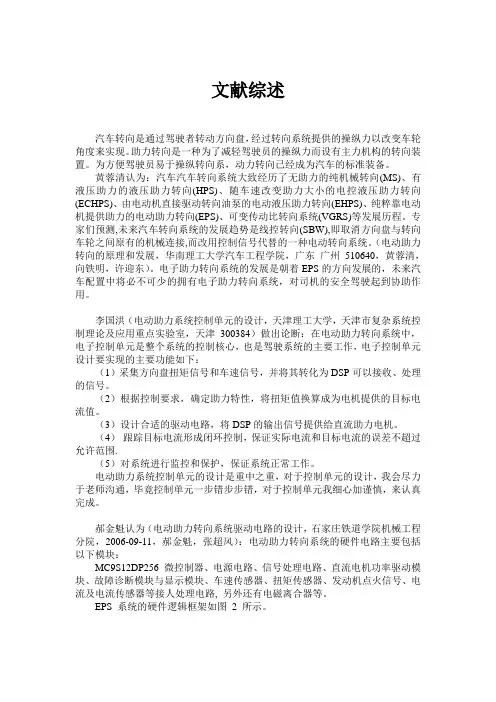
文献综述汽车转向是通过驾驶者转动方向盘,经过转向系统提供的操纵力以改变车轮角度来实现。
助力转向是一种为了减轻驾驶员的操纵力而设有主力机构的转向装置。
为方便驾驶员易于操纵转向系,动力转向已经成为汽车的标准装备。
黄蓉清认为:汽车汽车转向系统大致经历了无助力的纯机械转向(MS)、有液压助力的液压助力转向(HPS)、随车速改变助力大小的电控液压助力转向(ECHPS)、由电动机直接驱动转向油泵的电动液压助力转向(EHPS)、纯粹靠电动机提供助力的电动助力转向(EPS)、可变传动比转向系统(VGRS)等发展历程。
专家们预测,未来汽车转向系统的发展趋势是线控转向(SBW),即取消方向盘与转向车轮之间原有的机械连接,而改用控制信号代替的一种电动转向系统。
(电动助力转向的原理和发展,华南理工大学汽车工程学院,广东广州510640,黄蓉清,向铁明,许迎东)。
电子助力转向系统的发展是朝着EPS的方向发展的,未来汽车配置中将必不可少的拥有电子助力转向系统,对司机的安全驾驶起到协助作用。
李国洪(电动助力系统控制单元的设计,天津理工大学,天津市复杂系统控制理论及应用重点实验室,天津300384)做出论断:在电动助力转向系统中,电子控制单元是整个系统的控制核心,也是驾驶系统的主要工作,电子控制单元设计要实现的主要功能如下:(1)采集方向盘扭矩信号和车速信号,并将其转化为DSP可以接收、处理的信号。
(2)根据控制要求,确定助力特性,将扭矩值换算成为电机提供的目标电流值。
(3)设计合适的驱动电路,将DSP的输出信号提供给直流助力电机。
(4)跟踪目标电流形成闭环控制,保证实际电流和目标电流的误差不超过允许范围.(5)对系统进行监控和保护,保证系统正常工作。
电动助力系统控制单元的设计是重中之重,对于控制单元的设计,我会尽力于老师沟通,毕竟控制单元一步错步步错,对于控制单元我细心加谨慎,来认真完成。
郝金魁认为(电动助力转向系统驱动电路的设计,石家庄铁道学院机械工程分院,2006-09-11,郝金魁,张超风):电动助力转向系统的硬件电路主要包括以下模块:MC9S12DP256 微控制器、电源电路、信号处理电路、直流电机功率驱动模块、故障诊断模块与显示模块、车速传感器、扭矩传感器、发动机点火信号、电流及电流传感器等接人处理电路, 另外还有电磁离合器等。
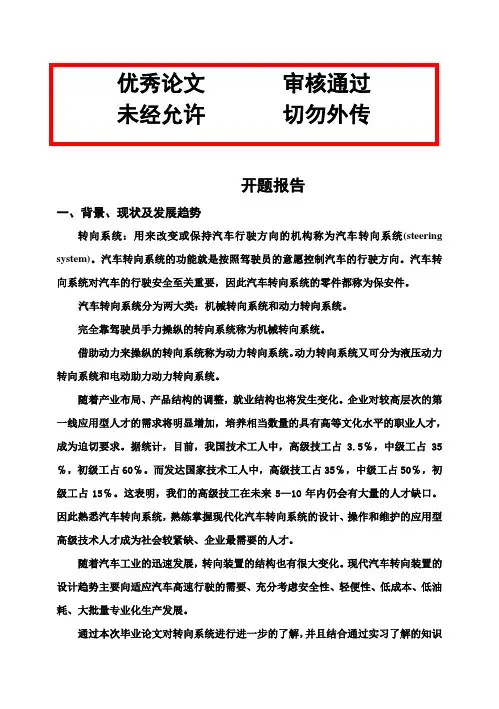
优秀论文审核通过未经允许切勿外传开题报告一、背景、现状及发展趋势转向系统:用来改变或保持汽车行驶方向的机构称为汽车转向系统(steering system)。
汽车转向系统的功能就是按照驾驶员的意愿控制汽车的行驶方向。
汽车转向系统对汽车的行驶安全至关重要,因此汽车转向系统的零件都称为保安件。
汽车转向系统分为两大类:机械转向系统和动力转向系统。
完全靠驾驶员手力操纵的转向系统称为机械转向系统。
借助动力来操纵的转向系统称为动力转向系统。
动力转向系统又可分为液压动力转向系统和电动助力动力转向系统。
随着产业布局、产品结构的调整,就业结构也将发生变化。
企业对较高层次的第一线应用型人才的需求将明显增加,培养相当数量的具有高等文化水平的职业人才,成为迫切要求。
据统计,目前,我国技术工人中,高级技工占 3.5℅,中级工占35℅,初级工占60℅。
而发达国家技术工人中,高级技工占35℅,中级工占50℅,初级工占15℅。
这表明,我们的高级技工在未来5—10年内仍会有大量的人才缺口。
因此熟悉汽车转向系统,熟练掌握现代化汽车转向系统的设计、操作和维护的应用型高级技术人才成为社会较紧缺、企业最需要的人才。
随着汽车工业的迅速发展,转向装置的结构也有很大变化。
现代汽车转向装置的设计趋势主要向适应汽车高速行驶的需要、充分考虑安全性、轻便性、低成本、低油耗、大批量专业化生产发展。
通过本次毕业论文对转向系统进行进一步的了解,并且结合通过实习了解的知识对转向系统的可能出现的问题进行分析和解决方法,从而提高自身对转向系统的深入认识二、设计目的通过本次毕业设计使自己对汽车转向系统在故障诊断和维修方面有更为充分、细致的理解,进一步掌握转向系统的原理、应用和CADCAM软件应用。
三、设计工作1、概述2、转向系统现阶段的主要类型3、汽车转向系统可能出现的问题和分析4、汽车转向系统的新发展---整体式、半分置式及联阀式动力转向结构四、时间安排项目时间截点备注论文题目确定2011年2月25日开题报告2011年3月4日论文初稿2011年4月15日论文定稿2011年5月7日论文答辩2011年5月15日二次答辩2011年5月22日目录浅析汽车转向系统常见故障诊断与维修 (2)摘要 (2)绪论 (3)1 概述 (4)1.1 什么是汽车转向系统 (4)1.2 汽车转向系统概述 (4)1.3 转向系统简介及工作原理 (4)2 汽车转向系统的故障诊断 (10)2.1 机械转向系故障诊断 (10)2.2 动力转向系故障诊断 (12)2.3 转向系仪器检测 (14)3对汽车转向系统的故障进行维修 (16)3.1机械转向系的维修 (16)3.2动力转向系的维修 (19)4结论……………………………………………………………………………………………22谢辞 (23)参考文献 (24)英文资料 (25)中文翻译 (30)浅析汽车转向系统常见故障诊断与维修摘要:本文阐述了汽车转向系统各个部分的作用、组成、主要构造、工作原理、及可能出现的故障,同时提出了对出现的故障进行维修的可行方案;采用了理论与实际相结合的方法,对每个问题都有良好的认识,对所学内容进行了良好的总结归纳,以此进一步熟悉掌握汽车转向系统的各方面知识,深化巩固所学知识,做到理论与实际相结合,在理论学习的前提下,用实际更好的理解所学内容。
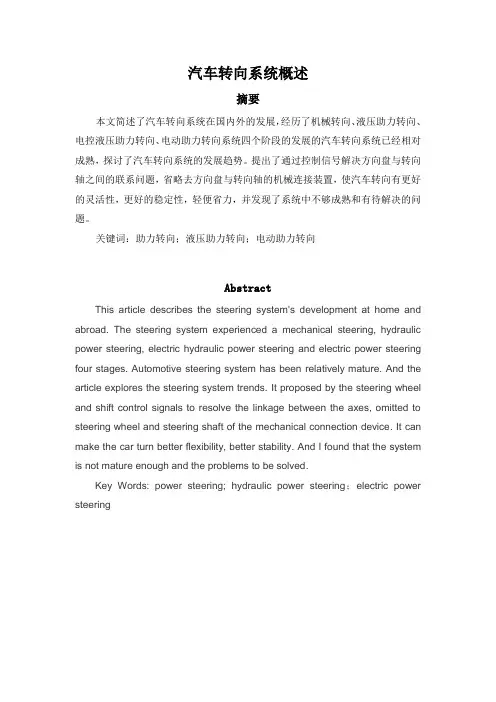
汽车转向系统概述摘要本文简述了汽车转向系统在国内外的发展,经历了机械转向、液压助力转向、电控液压助力转向、电动助力转向系统四个阶段的发展的汽车转向系统已经相对成熟,探讨了汽车转向系统的发展趋势。
提出了通过控制信号解决方向盘与转向轴之间的联系问题,省略去方向盘与转向轴的机械连接装置,使汽车转向有更好的灵活性,更好的稳定性,轻便省力,并发现了系统中不够成熟和有待解决的问题。
关键词:助力转向;液压助力转向;电动助力转向AbstractThis article describes the steering system's development at home and abroad. The steering system experienced a mechanical steering, hydraulic power steering, electric hydraulic power steering and electric power steering four stages. Automotive steering system has been relatively mature. And the article explores the steering system trends. It proposed by the steering wheel and shift control signals to resolve the linkage between the axes, omitted to steering wheel and steering shaft of the mechanical connection device. It can make the car turn better flexibility, better stability. And I found that the system is not mature enough and the problems to be solved.Key Words: power steering; hydraulic power steering;electric power steering引言汽车转向系统的发展经历了传统的机械转向、液压助力转向、电控液压助力转向、电动助力转向系统四个阶段。
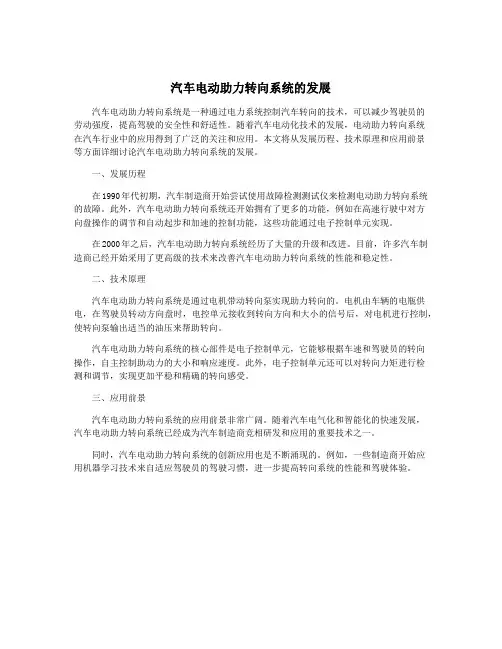
汽车电动助力转向系统的发展汽车电动助力转向系统是一种通过电力系统控制汽车转向的技术,可以减少驾驶员的劳动强度,提高驾驶的安全性和舒适性。
随着汽车电动化技术的发展,电动助力转向系统在汽车行业中的应用得到了广泛的关注和应用。
本文将从发展历程、技术原理和应用前景等方面详细讨论汽车电动助力转向系统的发展。
一、发展历程在1990年代初期,汽车制造商开始尝试使用故障检测测试仪来检测电动助力转向系统的故障。
此外,汽车电动助力转向系统还开始拥有了更多的功能,例如在高速行驶中对方向盘操作的调节和自动起步和加速的控制功能,这些功能通过电子控制单元实现。
在2000年之后,汽车电动助力转向系统经历了大量的升级和改进。
目前,许多汽车制造商已经开始采用了更高级的技术来改善汽车电动助力转向系统的性能和稳定性。
二、技术原理汽车电动助力转向系统是通过电机带动转向泵实现助力转向的。
电机由车辆的电瓶供电,在驾驶员转动方向盘时,电控单元接收到转向方向和大小的信号后,对电机进行控制,使转向泵输出适当的油压来帮助转向。
汽车电动助力转向系统的核心部件是电子控制单元,它能够根据车速和驾驶员的转向操作,自主控制助动力的大小和响应速度。
此外,电子控制单元还可以对转向力矩进行检测和调节,实现更加平稳和精确的转向感受。
三、应用前景汽车电动助力转向系统的应用前景非常广阔。
随着汽车电气化和智能化的快速发展,汽车电动助力转向系统已经成为汽车制造商竞相研发和应用的重要技术之一。
同时,汽车电动助力转向系统的创新应用也是不断涌现的。
例如,一些制造商开始应用机器学习技术来自适应驾驶员的驾驶习惯,进一步提高转向系统的性能和驾驶体验。
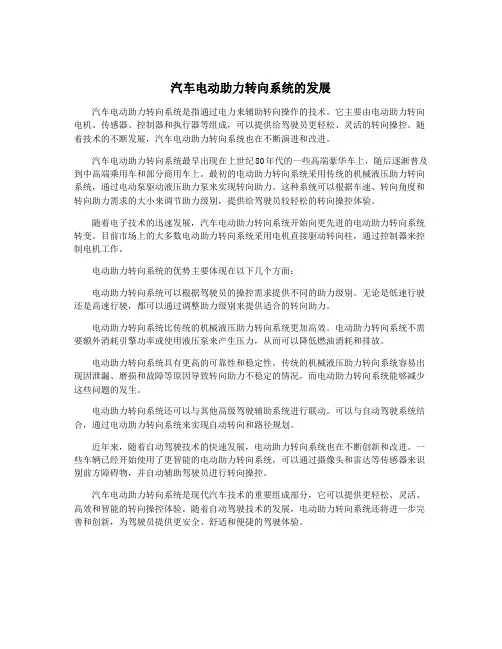
汽车电动助力转向系统的发展汽车电动助力转向系统是指通过电力来辅助转向操作的技术。
它主要由电动助力转向电机、传感器、控制器和执行器等组成,可以提供给驾驶员更轻松、灵活的转向操控。
随着技术的不断发展,汽车电动助力转向系统也在不断演进和改进。
汽车电动助力转向系统最早出现在上世纪80年代的一些高端豪华车上,随后逐渐普及到中高端乘用车和部分商用车上。
最初的电动助力转向系统采用传统的机械液压助力转向系统,通过电动泵驱动液压助力泵来实现转向助力。
这种系统可以根据车速、转向角度和转向助力需求的大小来调节助力级别,提供给驾驶员较轻松的转向操控体验。
随着电子技术的迅速发展,汽车电动助力转向系统开始向更先进的电动助力转向系统转变。
目前市场上的大多数电动助力转向系统采用电机直接驱动转向柱,通过控制器来控制电机工作。
电动助力转向系统的优势主要体现在以下几个方面:电动助力转向系统可以根据驾驶员的操控需求提供不同的助力级别。
无论是低速行驶还是高速行驶,都可以通过调整助力级别来提供适合的转向助力。
电动助力转向系统比传统的机械液压助力转向系统更加高效。
电动助力转向系统不需要额外消耗引擎功率或使用液压泵来产生压力,从而可以降低燃油消耗和排放。
电动助力转向系统具有更高的可靠性和稳定性。
传统的机械液压助力转向系统容易出现因泄漏、磨损和故障等原因导致转向助力不稳定的情况,而电动助力转向系统能够减少这些问题的发生。
电动助力转向系统还可以与其他高级驾驶辅助系统进行联动。
可以与自动驾驶系统结合,通过电动助力转向系统来实现自动转向和路径规划。
近年来,随着自动驾驶技术的快速发展,电动助力转向系统也在不断创新和改进。
一些车辆已经开始使用了更智能的电动助力转向系统,可以通过摄像头和雷达等传感器来识别前方障碍物,并自动辅助驾驶员进行转向操控。
汽车电动助力转向系统是现代汽车技术的重要组成部分,它可以提供更轻松、灵活、高效和智能的转向操控体验。
随着自动驾驶技术的发展,电动助力转向系统还将进一步完善和创新,为驾驶员提供更安全、舒适和便捷的驾驶体验。
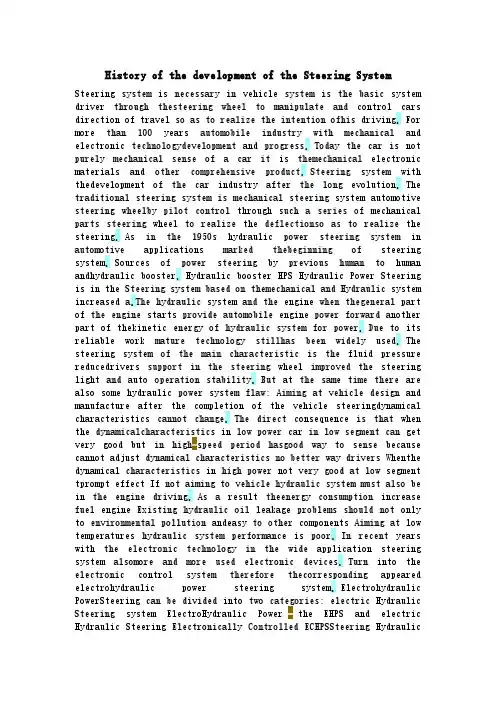
History of the development of the Steering SystemSteering system is necessary in vehicle system is the basic system driver through thesteering wheel to manipulate and control cars direction of travel so as to realize the intention ofhis driving. For more than 100 years automobile industry with mechanical and electronic technologydevelopment and progress. Today the car is not purely mechanical sense of a car it is themechanical electronic materials and other comprehensive product. Steering system with thedevelopment of the car industry after the long evolution. The traditional steering system is mechanical steering system automotive steering wheelby pilot control through such a series of mechanical parts steering wheel to realize the deflectionso as to realize the steering. As in the 1950s hydraulic power steering system in automotive applications marked thebeginning of steering system. Sources of power steering by previous human to human andhydraulic booster. Hydraulic booster HPS Hydraulic Power Steering is in the Steering system based on themechanical and Hydraulic system increased a.The hydraulic system and the engine when thegeneral part of the engine starts provide automobile engine power forward another part of thekinetic energy of hydraulic system for power. Due to its reliable work mature technology stillhas been widely used. The steering system of the main characteristic is the fluid pressure reducedrivers support in the steering wheel improved the steering light and auto operation stability. But at the same time there are also some hydraulic power system flaw: Aiming at vehicle design and manufacture after the completion of the vehicle steeringdynamical characteristics cannot change. The direct consequence is that when the dynamicalcharacteristics in low power car in low segment can get very good but in high speed period hasgood way to sense because cannot adjust dynamical characteristics no better way drivers Whenthe dynamical characteristics in high power not very good at low segment tprompt effect If not aiming to vehicle hydraulic system must also be in the engine driving. As a result theenergy consumption increase fuel engine Existing hydraulic oil leakage problems should not only to environmental pollution andeasy to other components Aiming at low temperatures hydraulic system performance is poor. In recent years with the electronic technology in the wide application steering system alsomore and more used electronic devices. Turn into the electronic control system therefore thecorresponding appeared electrohydraulic power steering system. Electrohydraulic PowerSteering can be divided into two categories: electric Hydraulic Steering system ElectroHydraulic Power the EHPS and electric Hydraulic Steering Electronically Controlled ECHPSSteering HydraulicPower Steering. Electric hydraulic steering system is in hydraulic powersystem on the basis of the development of hydraulic booster systems and different is electrichydraulic power system of power sources in the hydraulic system but not by motor enginemotor drive hydraulic system save energy and reduce the engine fuel consumption. Electrichydraulic steering is in traditional hydraulic booster systems on the basis of the development thedifference is that the electric hydraulic steering system electronic control devices increased. Theelectronic control unit can according to the steering rate speed auto operation parameters ofhydraulic system change the size of the hydraulic booster at different speeds so as to realize thechange dynamical characteristics. But under the motor drive hydraulic system in turn motorcan stop turning thereby reducing energy consumption. Although electrohydraulic power steering system of hydraulic steering overcomes thedrawbacks. But due to the existence of hydraulic system it exists the hydraulic oil leakageproblem and electrohydraulic power steering system introduced motor drive system is morecomplex costs and reliability.In order to avoid Electric hydraulic Steering system Electric Power Steering system ofElectric Power Steering EPS should now. It with all sorts of steering system the biggestdifference lies in the electric power steering system has no hydraulic system. Originallyproduced by hydraulic steering system by motor. Electric power steering system of general bythe torque sensor and microprocessor motor etc. The basic principle is: when the driver turnedthe steering wheel drive shaft rotation to install in the rotation axes of the torque sensor andtorque signal into electrical signals to microprocessors microprocessor based on speed andtorque signal other vehicles running parameters according to the set procedures in the treatmentof that power motors booster direction and the size of the booster. Since 1988 the first in Japansuzuki Cervo car to equip the steering system power steering system is widely recognized by thepeople. Steering system is mainly embodied in the following aspects: A power steering system can provide different at different speeds under the dynamicalcharacteristics. In the low road steering to increase more light At high speed reduced steeringeven in order to improve the road are increased to damp. A power steering system only in steering motors to work to provide power so as to reduceenergy consumption. A motor so by battery powered electric power steering system can not work in engineunder the condition of the work. Electric power steering system should not hydraulic system compared with hydraulicbooster systems and automated assembly. And electric power steering system can change thebooster program microprocessor algorithm easy dynamical characteristics of the change. Thedevelopment of science and technology is changing the traditional steering system ofsteering control wheel steering and turn of transmission mechanism. But the thought of thespark can always bring surprise Electronic Steering system SBW Steering to the Wire waschanged to the traditional concept of three most with micro controller it was replaced By theSteering transmission mechanism the three most into two parts. Electronic steering system is themost advanced and automotive steering system of technology. It mainly consists of steeringcontrol module to execute module and micro controller three modules. Steering control modules main function is to torque sensor detection by the driver intentionand to detect signal including rotation direction and rotational speed etc by bus to microcontroller and micro controller based on the signal and speed feedback control module is asteering wheel to make drivers can feel road. But this is the way is the development of virtualaccording to test data of integrated formed experience and by way of curing process in theform of micro controller. So it is with speed turning to the size of the torque rate and somecorresponding relation. Steering Angle sensor and actuator including steering motors steering motor controller etc.It is the function of micro controller based on the control command drive motor rotation Angleto execute complete to action. Also the size of the rotation Angle sensor monitoring andfeedback to micro controller forming a complete accurate closed loop control system steeringmovement. Micro controller is the core of electronic steering system. It is receiving signal detectionprocessed send corresponding control signal. Due to the micro controller replaced steering transmission mechanism thus mechanicalconnection between components of the system reduce the response speed and the accuracy ofthe response. And to turn strategy transmission control software programming any Settings Andother equipment such as ABS automatic navigation equipment. Transmission mechanism ofreducing brings a bigger car interior space give rides more fun. And turning behavior can berecorded save in software that can help EEPROM after further perfecting the steering controlstrategy even can provide evidence for the traffic accident. Auto safety question has been the focus of public attention. Steering system and lightingsystem can give at night traffic better security. Page shown above the traditional lighting systemis the vehicle to the front line irradiation vehicles and pedestrians in corners if drivers will behard to find in the corner pedestrians traffic accidents. If the lighting system combined with thesteering system pictured above when drivers in the steering wheel to the right of the steeringwheel Angle light with the right to change the more wide illumination turn lighting so in abroader range of pedestrian road corner will easilybe found. Currently the lighting technologyhas in the midrange Citroen triumph Toyota camrys are used. At present electronic steering system reliability and the cost is obstructed the development.If the micro controller is mainly manifested in the problem steering system will complete failureits not like electric power steering system and electric hydraulic steering system in the motor orhydraulic system also can appear when problems with human to control cars.Themicro controller electronic steering system malfunction because no mechanical systems can beconnected to the steering wheel and steering therefore impossible to control of the car. Butdespite the electronic steering system is still the future development direction of steering system.汽车转向系的发展历史转向系统是在车辆系统是必要的基本制度,通过方向盘司机操纵和控制汽车的方向旅行,以实现他的驾驶意图。
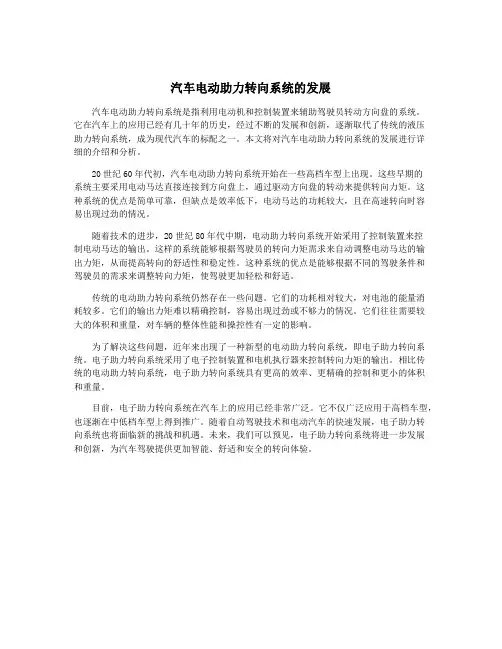
汽车电动助力转向系统的发展汽车电动助力转向系统是指利用电动机和控制装置来辅助驾驶员转动方向盘的系统。
它在汽车上的应用已经有几十年的历史,经过不断的发展和创新,逐渐取代了传统的液压助力转向系统,成为现代汽车的标配之一。
本文将对汽车电动助力转向系统的发展进行详细的介绍和分析。
20世纪60年代初,汽车电动助力转向系统开始在一些高档车型上出现。
这些早期的系统主要采用电动马达直接连接到方向盘上,通过驱动方向盘的转动来提供转向力矩。
这种系统的优点是简单可靠,但缺点是效率低下,电动马达的功耗较大,且在高速转向时容易出现过劲的情况。
随着技术的进步,20世纪80年代中期,电动助力转向系统开始采用了控制装置来控制电动马达的输出。
这样的系统能够根据驾驶员的转向力矩需求来自动调整电动马达的输出力矩,从而提高转向的舒适性和稳定性。
这种系统的优点是能够根据不同的驾驶条件和驾驶员的需求来调整转向力矩,使驾驶更加轻松和舒适。
传统的电动助力转向系统仍然存在一些问题。
它们的功耗相对较大,对电池的能量消耗较多。
它们的输出力矩难以精确控制,容易出现过劲或不够力的情况。
它们往往需要较大的体积和重量,对车辆的整体性能和操控性有一定的影响。
为了解决这些问题,近年来出现了一种新型的电动助力转向系统,即电子助力转向系统。
电子助力转向系统采用了电子控制装置和电机执行器来控制转向力矩的输出。
相比传统的电动助力转向系统,电子助力转向系统具有更高的效率、更精确的控制和更小的体积和重量。
目前,电子助力转向系统在汽车上的应用已经非常广泛。
它不仅广泛应用于高档车型,也逐渐在中低档车型上得到推广。
随着自动驾驶技术和电动汽车的快速发展,电子助力转向系统也将面临新的挑战和机遇。
未来,我们可以预见,电子助力转向系统将进一步发展和创新,为汽车驾驶提供更加智能、舒适和安全的转向体验。
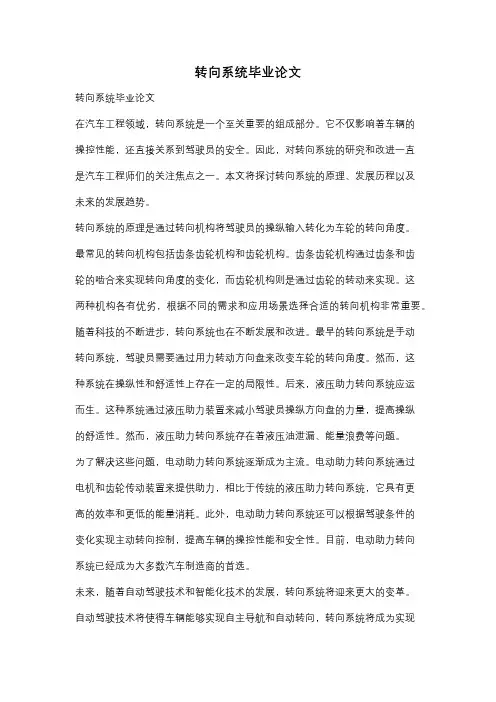
转向系统毕业论文转向系统毕业论文在汽车工程领域,转向系统是一个至关重要的组成部分。
它不仅影响着车辆的操控性能,还直接关系到驾驶员的安全。
因此,对转向系统的研究和改进一直是汽车工程师们的关注焦点之一。
本文将探讨转向系统的原理、发展历程以及未来的发展趋势。
转向系统的原理是通过转向机构将驾驶员的操纵输入转化为车轮的转向角度。
最常见的转向机构包括齿条齿轮机构和齿轮机构。
齿条齿轮机构通过齿条和齿轮的啮合来实现转向角度的变化,而齿轮机构则是通过齿轮的转动来实现。
这两种机构各有优劣,根据不同的需求和应用场景选择合适的转向机构非常重要。
随着科技的不断进步,转向系统也在不断发展和改进。
最早的转向系统是手动转向系统,驾驶员需要通过用力转动方向盘来改变车轮的转向角度。
然而,这种系统在操纵性和舒适性上存在一定的局限性。
后来,液压助力转向系统应运而生。
这种系统通过液压助力装置来减小驾驶员操纵方向盘的力量,提高操纵的舒适性。
然而,液压助力转向系统存在着液压油泄漏、能量浪费等问题。
为了解决这些问题,电动助力转向系统逐渐成为主流。
电动助力转向系统通过电机和齿轮传动装置来提供助力,相比于传统的液压助力转向系统,它具有更高的效率和更低的能量消耗。
此外,电动助力转向系统还可以根据驾驶条件的变化实现主动转向控制,提高车辆的操控性能和安全性。
目前,电动助力转向系统已经成为大多数汽车制造商的首选。
未来,随着自动驾驶技术和智能化技术的发展,转向系统将迎来更大的变革。
自动驾驶技术将使得车辆能够实现自主导航和自动转向,转向系统将成为实现这一目标的关键。
同时,智能化技术的应用也将为转向系统带来更多的可能性。
例如,通过传感器和智能算法,转向系统可以根据驾驶员的行为和路况实时调整车轮的转向角度,提供更加精准和安全的操控。
总之,转向系统作为汽车工程的重要组成部分,不断发展和改进。
从手动转向系统到液压助力转向系统,再到电动助力转向系统,每一次变革都使得驾驶更加轻松和安全。
汽车转向机构的发展过程及现状随着汽车工业的不断发展,转向机构作为汽车的重要组成部分,经历了多次的技术革新。
从早期的机械转向系统到现代的线控转向系统,转向机构在操作便利性、安全性及效率等方面得到了显著提升。
本文将对汽车转向机构的发展历程、现状、各系统性能对比、影响发展的因素及安全性能的改进进行详细阐述。
一、机械转向系统机械转向系统是最早的转向系统形式,其工作原理是通过驾驶者施加在方向盘上的力矩,经由转向柱、转向中间轴等机械部件传递至转向器,进而改变车轮的方向。
但随着汽车动力的增加和行驶速度的提高,驾驶者需要承受较大的转向力矩,操作起来较为费力。
二、液压助力转向系统为了减轻驾驶者的操作强度,液压助力转向系统应运而生。
该系统通过液压泵产生的压力,协助驾驶者完成转向动作。
相比于机械转向系统,液压助力转向系统显著降低了驾驶者需要承受的力矩,提高了操作的便利性。
三、电控液压助力转向系统随着电子技术的进步,电控液压助力转向系统逐渐取代了传统的液压助力转向系统。
该系统通过电子控制单元对液压泵的调节,实现压力的无级调节,以适应不同的转向需求。
此外,电控液压助力转向系统还增加了许多智能功能,如主动回正、车速感应等。
四、电动助力转向系统电动助力转向系统是近年来发展最为迅速的转向系统。
该系统通过电动机直接提供转向助力,不再使用液压泵和液压管路等部件,结构更加紧凑,同时降低了能耗。
电动助力转向系统的控制精度高,可以实现多种智能操控功能,如主动避障、车道保持等。
五、线控转向系统线控转向系统是未来转向技术的发展方向。
该系统取消了方向盘与转向轮之间的机械连接,通过电线传递信号控制电动机实现转向动作。
线控转向系统具有高度的灵活性,可以优化汽车的布局设计,为汽车创造更大的内部空间。
同时,线控转向系统还有助于实现自动驾驶功能。
六、现状与未来趋势目前,电动助力转向系统已成为市场主流。
由于其具有节能环保、高精度控制等优点,各大汽车厂商纷纷投入研发和生产。
汽车转向系统的发展及展望近年来,随着社会生活的汽车化,汽车的保有量不断增加,由此造成交通情况错综复杂,使得驾驶员转向盘的操作频率增大,这就需要减轻驾驶疲劳,提高操纵的轻便性和灵活性,因此对动力转向系统的要求也越来越高。
至今,汽车转向系统经历了传统机械转向系统、液压助力转向系统、电液助力转向系统和电动助力转向系统4个发展阶段,未来则可能向线控动力转向系统发展。
目前汽车转向系统正处在液压助力转向系统、电液助力转向系统向电动助力转向系统发展的过渡阶段[1]。
1 传统机械转向系统传统机械转向系统(MS)主要由转向操纵机构、转向器和转向传动机构3部分组成。
转向操纵机构是驾驶员操纵转向器工作的机构,包括从方向盘到转向器输入端的零部件。
转向器是把方向盘传来的转矩按一定传动比放大并输出的增力装置,转向器最早采用的是蜗轮蜗杆式,以后陆续出现了螺杆螺母式、齿轮齿条式、循环球式等形式。
转向传动机构是把转向器输出的力矩传递给转向车轮的机构,包括从转向摇臂到转向车轮的零部件[2]。
当汽车需要改变行驶方向时,驾驶员通过转动方向盘,转向力矩经由转向轴、转向器、直拉杆、横拉杆和梯形臂等机件使转向节偏转,实现汽车方向的改变。
传统机械转向系统的优点是结构简单、工作可靠、生产成本低。
其缺点也非常明显:①随着汽车速度的提高和汽车质量的增大,转向操纵难度增大,转向越来越费力。
②是其传动比是固定的,即角传递特性无法改变,导致汽车的转向响应特性无法控制,传动比无法随汽车转向过程中的车速、侧向加速度等参数的变化而进行补偿,驾驶员必须在转向之前就对汽车的转向响应特性进行一定的操作补偿,这样无形中增加了驾驶员的精神和体力负担[2]。
2液压助力转向系统液压助力转向系统(HPS)是在传统机械转向系统基础上额外加装了一套液压助力系统,一般由油泵、V形带轮、油管、供油装置、助力装置和控制阀等组成。
它以液压油为动力,通过液压泵产生的动力来推动机械转向器工作。
附录附录A 英文文献Along with automobile electronic technology swift and violent development, the people also day by day enhance to the motor turning handling quality request. The motor turning system changed, the hydraulic pressure boost from the traditional machinery changes (Hydraulic Power Steering, is called HPS), the electrically controlled hydraulic pressure boost changes (Elect ric Hydraulic Power Steering, is called EHPS), develops the electrically operated boost steering system (Elect ric Power Steering, is called EPS), finally also will transit to the line controls the steering system (Steer By Wire, will be called SBW).The machinery steering system is refers by pilot's physical strength achievement changes the energy, in which all power transmission all is mechanical, the automobile changes the movement is operates the steering wheel by the pilot, transmits through the diverter and a series of members changes the wheel to realize. The mechanical steering system by changes the control mechanism, the diverter and major part changes the gearing 3 to be composed.Usually may divide into according to the mechanical diverter form: The gear rack type, follows round the world -like, the worm bearing adjuster hoop type, the worm bearing adjuster refers sells the type. Is the gear rack type and follows using the broadest two kinds round the world -like (uses in needing time big steering force).In follows round the world -like in the diverter, the input changes the circle and the output steering arm pivot angle is proportional; In the gear rack type diverter, the input changes the turn and the output rack displacement is proportional. Follows round the world -like the diverter because is the rolling friction form, thus the transmission efficiency is very high, the ease of operation also the service life are long, moreover bearing capacity, therefore widely applies on the truck. The gear rack type diverter with follows round the world -like compares, the most major characteristic is the rigidity is big, the structure compact weight is light, also the cost is low. Because this way passes on easily by the wheel the reacting force to the steering wheel, therefore has to the pavement behavior response keen merit, but simultaneously also easy to have phenomena and so on goon and oscillation, also its load bearing efficiency relativeweak, therefore mainly applies on the compact car and the pickup truck, at present the majority of low end passenger vehicle uses is the gear rack type machinery steering system.Along with the vehicles carrying capacity increase as well as the people to the vehicles handling quality request enhancement, the simple mechanical type steering system were already unable to meet the needs, the power steering system arise at the historic moment, it could rotate the steering wheel while the pilot to provide the boost, the power steering system divides into the hydraulic pressure steering system and the electrically operated steering system 2 kinds.Hydraulic pressure steering system is at present uses the most widespread steering system.The hydraulic pressure steering system increased the hydraulic system in the mechanical system foundation, including hydraulic pump, V shape band pulley, drill tubing, feed installment, boost installment and control valve. It with the aid of in the motor car engine power actuation hydraulic pump, the air compressor and the generator and so on, by the fluid strength, the physical strength or the electric power increases the pilot to operate the strength which the front wheel changes, enables the pilot to be possible nimbly to operate motor turning facilely, reduced the labor intensity, enhanced the travel security.The hydraulic pressure boost steering system from invented already had about half century history to the present, might say was one kind of more perfect system, because its work reliable, the technology mature still widely is applied until now. It takes the power supply by the hydraulic pump, after oil pipe-line control valves to power hydraulic cylinder feed, through the connecting rod impetus rotation gear movement, may changes the boost through the change cylinder bore and the flowing tubing head pressure size the size, from this achieved changes the boost the function. The traditional hydraulic pressure type power steering system may divide into generally according to the liquid flow form: Ordinary flow type and atmospheric pressure type 2 kind of types, also may divide into according to the control valve form transfers the valve type and the slide-valve type.Along with hydraulic pressure power steering system on automobile daily popularization, the people to operates when the portability and the road feeling request also day by day enhance, however the hydraulic pressure power steering system has many shortcomings actually: ①Because its itself structure had decided it is unable to guarantee vehicles rotates the steering wheel when any operating mode, all has the ideal operation stability, namely is unable simultaneously to guarantee time the low speed changes theportability and the high speed time operation stability;②The automobile changes the characteristic to drive the pilot technical the influence to be serious; ③The steering ratio is fixed, causes the motor turning response characteristic along with changes and so on vehicle speed, transverse acceleration to change, the pilot must aim at the motor turning characteristic peak-to-peak value and the phase change ahead of time carries on certain operation compensation, thus controls the automobile according to its wish travel. Like this increased pilot's operation burden, also causes in the motor turning travel not to have the security hidden danger; But hereafter appeared the electrically controlled hydraulic booster system, it increases the velocity generator in the traditional hydraulic pressure power steering system foundation, enables the automobile along with the vehicle speed change automatic control force size, has to a certain extent relaxed the traditional hydraulic pressure steering system existence question.At present our country produces on the commercial vehicle and the passenger vehicle uses mostly is the electrically controlled hydraulic pressure boost steering system, it is quite mature and the application widespread steering system. Although the electrically controlled hydraulic servo alleviated the traditional hydraulic pressure from certain degree to change between the portability and the road feeling contradiction, however it did not have fundamentally to solve the HPS system existence insufficiency, along with automobile microelectronic technology development, automobile fuel oil energy conservation request as well as global initiative environmental protection, it in aspect and so on arrangement, installment, leak-proof quality, control sensitivity, energy consumption, attrition and noise insufficiencies already more and more obvious, the steering system turned towards the electrically operated boost steering system development.The electrically operated boost steering system is the present mo tor turning system development direction, its principle of work is: EPS system ECU after comes from the steering wheel torque sensor and the vehicle speed sensor signal carries on analysis processing, controls the electrical machinery to have the suitable boost torque, assists the pilot to complete changes the operation. In the last few years, along with the electronic technology development, reduces EPS the cost to become large scale possibly, Japan sends the car company, Mitsubishi Car company, this field car company, US's Delphi automobile system company, TRW Corporation and Germany's ZF Corporation greatly all one after another develops EPS.Mercedes2Benz and Siemens Automotive two big companiesinvested 65,000,000 pounds to use in developing EPS, the goal are together load a car to 2002, yearly produce 300 ten thousand sets, became the global EPS manufacturer. So far, the EPS system in the slight passenger vehicle, on the theater box type vehicle obtains the widespread application, and every year by three million speed development.Steering is the term applied to the collection of components, linkages, etc. which allow for a vessel (ship, boat) or vehicle (car) to follow the desired course. An exception is the case of rail transport by which rail tracks combined together with railroad switches provide the steering function.The most conventional steering arrangement is to turn the front wheels using a hand–operated steering wheel which is positioned in front of the driver, via the steering column, which may contain universal joints to allow it to deviate somewhat from a straight line. Other arrangements are sometimes found on different types of vehicles, for example, a tiller or rear–wheel steering. Tracked vehicles such as tanks usually employ differential steering —that is, the tracks are made to move at different speeds or even in opposite directions to bring about a change of course.Many modern cars use rack and pinion steering mechanisms, where the steering wheel turns the pinion gear; the pinion moves the rack, which is a sort of linear gear which meshes with the pinion, from side to side. This motion applies steering torque to the kingpins of the steered wheels via tie rods and a short lever arm called the steering arm.Older designs often use the recirculating ball mechanism, which is still found on trucks and utility vehicles. This is a variation on the older worm and sector design; the steering column turns a large screw (the "worm gear") which meshes with a sector of a gear, causing it to rotate about its axis as the worm gear is turned; an arm attached to the axis of the sector moves the pitman arm, which is connected to the steering linkage and thus steers the wheels. The recirculating ball version of this apparatus reduces the considerable friction by placing large ball bearings between the teeth of the worm and those of the screw; at either end of the apparatus the balls exit from between the two pieces into a channel internal to the box which connects them with the other end of the apparatus, thus they are "recirculated".The rack and pinion design has the advantages of a large degree of feedback and direct steering "feel"; it also does not normally have any backlash, or slack. A disadvantage is that it is not adjustable, so that when it does wear and develop lash, the only cure is replacement.The recirculating ball mechanism has the advantage of a much greater mechanical advantage, so that it was found on larger, heavier vehicles while the rack and pinion was originally limited to smaller and lighter ones; due to the almost universal adoption of power steering, however, this is no longer an important advantage, leading to the increasing use of rack and pinion on newer cars. The recirculating ball design also has a perceptible lash, or "dead spot" on center, where a minute turn of the steering wheel in either direction does not move the steering apparatus; this is easily adjustable via a screw on the end of the steering box to account for wear, but it cannot be entirely eliminated or the mechanism begins to wear very rapidly. This design is still in use in trucks and other large vehicles, where rapidity of steering and direct feel are less important than robustness, maintainability, and mechanical advantage. The much smaller degree of feedback with this design can also sometimes be an advantage; drivers of vehicles with rack and pinion steering can have their thumbs broken when a front wheel hits a bump, causing the steering wheel to kick to one side suddenly (leading to driving instructors telling students to keep their thumbs on the front of the steering wheel, rather than wrapping around the inside of the rim). This effect is even stronger with a heavy vehicle like a truck; recirculating ball steering prevents this degree of feedback, just as it prevents desirable feedback under normal circumstances.The steering linkage connecting the steering box and the wheels usually conforms to a variation of Ackermann steering geometry, to account for the fact that in a turn, the inner wheel is actually traveling a path of smaller radius than the outer wheel, so that the degree of toe suitable for driving in a straight path is not suitable for turns.As vehicles have become heavier and switched to front wheel drive, the effort to turn the steering wheel manually has increased - often to the point where major physical exertion is required. To alleviate this, auto makers have developed power steering systems. There are two types of power steering systems—hydraulic and electric/electronic. There is also a hydraulic-electric hybrid system possible.A hydraulic power steering (HPS) uses hydraulic pressure supplied by an engine-driven pump to assist the motion of turning the steering wheel. Electric power steering (EPS) is more efficient than the hydraulic power steering, since the electric power steering motor only needs to provide assist when the steering wheel is turned, whereas the hydraulic pump must run constantly. In EPS the assist level is easily tunable to the vehicletype, road speed, and even driver preference. An added benefit is the elimination of environmental hazard posed by leakage and disposal of hydraulic power steering fluid.An outgrowth of power steering is speed adjustable steering, where the steering is heavily assisted at low speed and lightly assisted at high speed. The auto makers perceive that motorists might need to make large steering inputs while manoeuvering for parking, but not while traveling at high speed. The first vehicle with this feature was the Citroën SM with its Diravi layout, although rather than altering the amount of assistance as in modern power steering systems, it altered the pressure on a centring cam which made the steering wheel try to "spring" back to the straight-ahead position. Modern speed-adjustable power steering systems reduce the pressure fed to the ram as the speed increases, giving a more direct feel. This feature is gradually becoming commonplace across all new vehicles.Four-wheel steering (or all wheel steering) is a system employed by some vehicles to increase vehicle stability while maneuvering at high speed, or to decrease turning radius at low speed.In most four-wheel steering systems, the rear wheels are steered by a computer and actuators. The rear wheels generally cannot turn as far as the Alternatively, several systems, including Delphi's Quadrasteer and the system in Honda's Prelude line, allow for the rear wheels to be steered in the opposite direction as the front wheels during low speeds. This allows the vehicle to turn in a significantly smaller radius —sometimes critical for large trucks or vehicles with trailers.附录B 文献翻译随着汽车电子技术的迅猛发展,人们对汽车转向操纵性能的要求也日益提高。